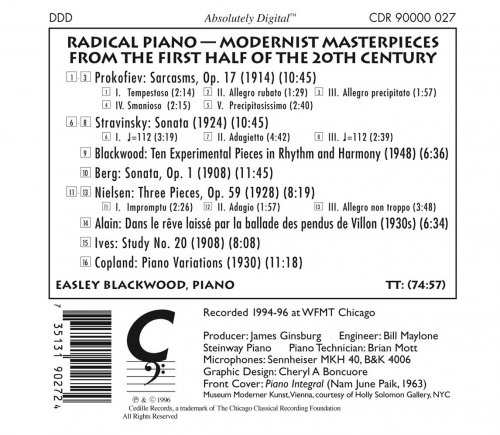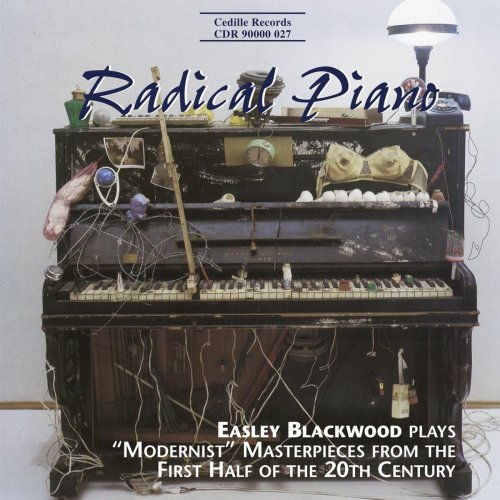
Easley Blackwood - Blackwood, Easley: Radical Piano (2010)
BAND/ARTIST: Easley Blackwood
- Title: Blackwood, Easley: Radical Piano
- Year Of Release: 2010
- Label: Cedille Records
- Genre: Classical Piano
- Quality: flac lossless (tracks) +Booklet
- Total Time: 01:14:54
- Total Size: 233 mb
- WebSite: Album Preview
Tracklist
01. Sarcasms, Op. 17: I. Tempestoso
02. Sarcasms, Op. 17: II. Allegro Rubato
03. Sarcasms, Op. 17: III. Allegro Precipitato
04. Sarcasms, Op. 17: IV. Smanioso
05. Sarcasms, Op. 17: V. Precipitosissimo
06. Piano Sonata (1924): I. (quarter Note = 112)
07. Piano Sonata (1924): II. Adagietto
08. Piano Sonata (1924): III. (quarter Note = 112)
09. 10 Experimental Pieces In Rhythm and Harmony: Ten Experimental Pieces In Rhythm and Harmony
10. Piano Sonata, Op. 1
11. 3 Piano Pieces, Op. 59, FS 131 : I. Impromptu
12. 3 Piano Pieces, Op. 59, FS 131 : II. Adagio
13. 3 Piano Pieces, Op. 59, FS 131 : III. Allegro Non Troppo
14. Dans Le Reve Laisse Par la Ballade Des Pendus de Villon
15. Study No. 20
16. Piano Variations

One look at the garbage-bedecked piano on the cover of Radical Piano and you know this isn’t “Dinner Classics.”
Yet this survey of early modernism is far from an assault on anyone’s aesthetic sensibilities. Pianist and composer Easley Blackwood performs a novel program of modernist masterpieces from the first half of the 20th century — nearly 75 minutes of music by modernist icons, as well as composers best known for conventional lyricism, such as Copland, Nielsen, and Prokofiev. Most of the works have rarely, if ever, been recorded.
Twentieth-century piano music has been known to provoke uprisings: listeners rise up and leave the room. Radical Piano consciously tries to hold onto the audience. One hears striking dissonances, surprising mood changes, and aggressive rhythmic elements, but nothing approaching complete atonality. It’s music that breaks the mold, without destroying the patience of mainstream listeners.
For a pleasing balance, the more dissonant works are, for the most part, separated by less dissonant ones. Stylistically, works are grouped into Russian, Western European, and American categories.
The opener, Prokofiev’s arresting Sarcasms, Op. 17, is a set of five “barbaric” and “sardonic” pieces completed in 1914. It was among a burst of defiant works composed (presumably) in response to critics who panned his adventurous First Piano Concerto. Stravinsky’s neoclassical Piano Sonata (1924) has elements of wit and caprice, as well as subtle tenderness.
American composer Blackwood acknowledges the stylistic influences of Stravinsky and Viennese-school composers Berg and schönberg in his Ten Experimental Pieces in Rhythm and Harmony (1948). Written when he was a 15-year-old student at the Berkshire Music Center, Blackwood views them today as “amusing divertimenti . . . more than mere juvenalia.” This is their world-premiere recording.
Berg’s single-movement Sonata, Op. 1 (1908), creates an elaborate “hyper-romantic” mood with its numerous frantic climaxes of increased volume and tempo. Nielsen’s ingenious Three Pieces, Op. 59 (1928), show his late interest in transitional post-tonal modernism — a radical departure from his better-known compositions. Alain’s haunting Dans le rêve laissé par la ballade des pendus de Villon (1930s) translates as “In the dream left by Villon’s Ballade of the Hanged Men.” Alain, known almost exclusively for his organ music, seems to prefigure the advent of minimalism in this rare piano composition.
Ives’ Study No. 20 (1908) contains contrasting sections of highly dissonant impressionism, followed by a hymn tune, a stately march, and a hilarious ragtime shuffle. This is the Study’s first recording expressly for CD. Lastly, Copland’s Piano Variations (1930) evinces a rugged modernism far removed from his more readily accessible compositions. “It is one of the remarkable features of the work that the same basic idea can be made to undergo such a variety of moods, ” Blackwood writes in the CD notes.
All these works make huge demands on the pianist — sudden and dramatic dynamic contrasts, tough-to-time rests, ultra-quiet passages, and virtuosic trills and runs. In Blackwood, Cedille has a pianist the Boston Globe describes as “famous for his ability to play music others dismiss as ‘unperformable’.”
01. Sarcasms, Op. 17: I. Tempestoso
02. Sarcasms, Op. 17: II. Allegro Rubato
03. Sarcasms, Op. 17: III. Allegro Precipitato
04. Sarcasms, Op. 17: IV. Smanioso
05. Sarcasms, Op. 17: V. Precipitosissimo
06. Piano Sonata (1924): I. (quarter Note = 112)
07. Piano Sonata (1924): II. Adagietto
08. Piano Sonata (1924): III. (quarter Note = 112)
09. 10 Experimental Pieces In Rhythm and Harmony: Ten Experimental Pieces In Rhythm and Harmony
10. Piano Sonata, Op. 1
11. 3 Piano Pieces, Op. 59, FS 131 : I. Impromptu
12. 3 Piano Pieces, Op. 59, FS 131 : II. Adagio
13. 3 Piano Pieces, Op. 59, FS 131 : III. Allegro Non Troppo
14. Dans Le Reve Laisse Par la Ballade Des Pendus de Villon
15. Study No. 20
16. Piano Variations

One look at the garbage-bedecked piano on the cover of Radical Piano and you know this isn’t “Dinner Classics.”
Yet this survey of early modernism is far from an assault on anyone’s aesthetic sensibilities. Pianist and composer Easley Blackwood performs a novel program of modernist masterpieces from the first half of the 20th century — nearly 75 minutes of music by modernist icons, as well as composers best known for conventional lyricism, such as Copland, Nielsen, and Prokofiev. Most of the works have rarely, if ever, been recorded.
Twentieth-century piano music has been known to provoke uprisings: listeners rise up and leave the room. Radical Piano consciously tries to hold onto the audience. One hears striking dissonances, surprising mood changes, and aggressive rhythmic elements, but nothing approaching complete atonality. It’s music that breaks the mold, without destroying the patience of mainstream listeners.
For a pleasing balance, the more dissonant works are, for the most part, separated by less dissonant ones. Stylistically, works are grouped into Russian, Western European, and American categories.
The opener, Prokofiev’s arresting Sarcasms, Op. 17, is a set of five “barbaric” and “sardonic” pieces completed in 1914. It was among a burst of defiant works composed (presumably) in response to critics who panned his adventurous First Piano Concerto. Stravinsky’s neoclassical Piano Sonata (1924) has elements of wit and caprice, as well as subtle tenderness.
American composer Blackwood acknowledges the stylistic influences of Stravinsky and Viennese-school composers Berg and schönberg in his Ten Experimental Pieces in Rhythm and Harmony (1948). Written when he was a 15-year-old student at the Berkshire Music Center, Blackwood views them today as “amusing divertimenti . . . more than mere juvenalia.” This is their world-premiere recording.
Berg’s single-movement Sonata, Op. 1 (1908), creates an elaborate “hyper-romantic” mood with its numerous frantic climaxes of increased volume and tempo. Nielsen’s ingenious Three Pieces, Op. 59 (1928), show his late interest in transitional post-tonal modernism — a radical departure from his better-known compositions. Alain’s haunting Dans le rêve laissé par la ballade des pendus de Villon (1930s) translates as “In the dream left by Villon’s Ballade of the Hanged Men.” Alain, known almost exclusively for his organ music, seems to prefigure the advent of minimalism in this rare piano composition.
Ives’ Study No. 20 (1908) contains contrasting sections of highly dissonant impressionism, followed by a hymn tune, a stately march, and a hilarious ragtime shuffle. This is the Study’s first recording expressly for CD. Lastly, Copland’s Piano Variations (1930) evinces a rugged modernism far removed from his more readily accessible compositions. “It is one of the remarkable features of the work that the same basic idea can be made to undergo such a variety of moods, ” Blackwood writes in the CD notes.
All these works make huge demands on the pianist — sudden and dramatic dynamic contrasts, tough-to-time rests, ultra-quiet passages, and virtuosic trills and runs. In Blackwood, Cedille has a pianist the Boston Globe describes as “famous for his ability to play music others dismiss as ‘unperformable’.”
As a ISRA.CLOUD's PREMIUM member you will have the following benefits:
- Unlimited high speed downloads
- Download directly without waiting time
- Unlimited parallel downloads
- Support for download accelerators
- No advertising
- Resume broken downloads


